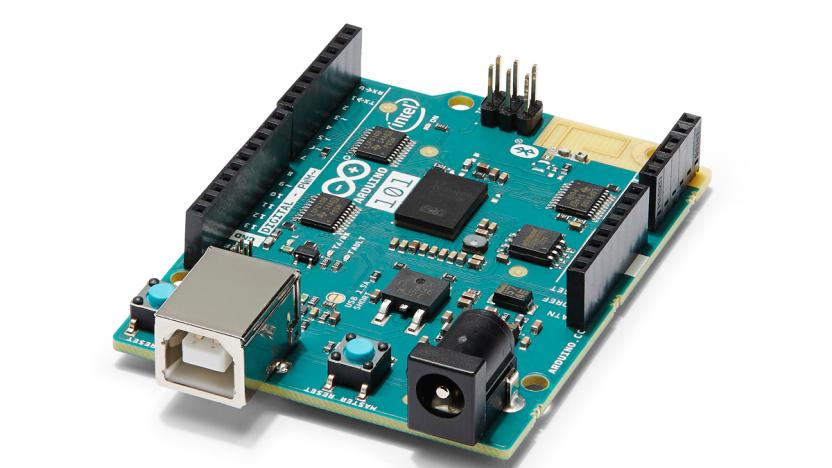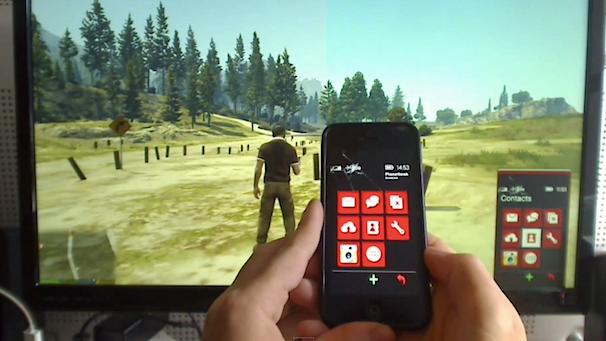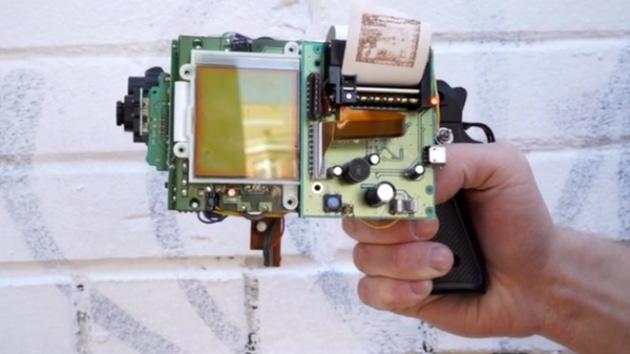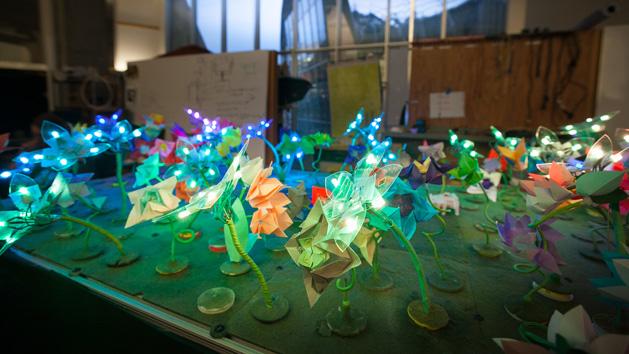arduino
Latest

This DIY sonar glove can 'feel' distant objects underwater
If you live in a relatively dry climate, you probably don't worry about underwater hazards during the flood season. If you attend Tsukuba University, Japan however -- just miles from where the Kinugawa River flooded Joso City earlier this year -- the risk of rising water is a very real threat. Enough so that two Tsukuba Ph.D. candidates have developed a 3D-printed sonar glove specifically for the purpose of searching flood waters.

These DIY Netflix socks pause your show when you fall asleep
Passing out during a Netflix session is a very real threat. Especially with the incoming holiday season and all those requisite carbs pumping in your bloodstream. So Netflix's latest make it project attempts to solve the issue with motion sensors built into your socks. (Vaguely festive PR grab, check.) Netflix has provisioned some sock designs if you're a truly devoted binge-watcher, and offers up all the details for the intermediate-level electronics (Arduino, accelerometers, IR LEDs) needed to make it work. Your handmade wearables might not work all the time, but at least you'll be a little closer to find exactly which episode of Jessica Jones you unintentionally faded out from.

Jolly Tracker forces holiday cheer with a shock to the face
The holiday season is supposed to be a happy time. But lets be honest, between the stress of picking out gifts, racking up credit card debt you can't afford and being forced to spend time with your creepy uncle there isn't a lot to smile about. Enter the JöLLY Tracker. It's a wearable of a different kind -- one that monitors just how much you smile. And, if you're not keeping that frown turned upside down, it gives you a gentle "reminder" to smile in the form of an electric shock... to the face.

Pay Humble Bundle $15, get $276 worth of maker know-how
Humble Bundle unveiled its latest book pack on Wednesday and, hoo boy, is it a doozy. The pay-what-you-want charity is teaming up with Make for a huge book pack that teaches the basics of Arduino and Pi programming. Pay anything you want for six Maker handbooks geared towards amateur roboticists. Throw down more than the current $10 average and Humble Bundle will double that figure to include a full dozen titles as well as a $5 - $10 discount off a year of Maker Magazine. You can also round out the deal for $15 total and receive two more titles -- Make: Sensors and Making Things Talk. Proceeds from these sales will benefit Maker Ed.[Image Credit: Getty]

Guy creates handheld railgun with a 3D-printer
An ambitious maker has built a partly 3D-printed railgun that can fire aluminum or graphite projectiles at over 250 meters per second (560 mph). No, this isn't Quake, but it's no janky, all-plastic gun, either. The "handheld" weapon houses six capacitors that weigh 20 pounds and deliver over 1,800 joules of energy per shot. And it indeed works just like a full-sized railgun, using parallel electrodes to fire an "armature" bullet. The creator, David Wirth, added an Arduino Uno R3 to monitor charging levels, temperature and other factors, and tweaked the rails after he noticed "plasma damage."

Intel throws its tiny Curie module in an Arduino board
The low-power Curie from Intel helps developers quickly prototype a device with turn-key access to Bluetooth, a six-axis sensor with gyroscope and accelerometer and the 32-bit SOC Quark micro-controller. It's main focus has been the wearable market and since its introduction at CES 2015, it's has been used in sports bras, creepy robot spiders and to measure wicked-cool bike tricks. Now it's being included in a new Arduino board. The Arduino 101 (internationally it'll be called, Genuino 101) is the first widely available development board for the tiny chip. Priced at a reasonable $30 and using the same open-source platform as the rest of the Arduino line, the 101 is targeted at students and makers looking to add some connectivity to a project.

ICYMI: Becoming Thor, the future of beekeeping and more
#fivemin-widget-blogsmith-image-215343{display:none;} .cke_show_borders #fivemin-widget-blogsmith-image-215343, #postcontentcontainer #fivemin-widget-blogsmith-image-215343{width:570px;display:block;} try{document.getElementById("fivemin-widget-blogsmith-image-215343").style.display="none";}catch(e){}Today on In Case You Missed It: The FlowHive is a new bee colony rig that allows beekeepers to tap the honey easily by cranking open the honeycomb design, creating a channel down to the spout. Japanese inventors created a throwable robot that flies through the air as a sphere, then unfurls four legs to scuttle its way onward. And maker Alan Phan re-created the God Hammer aka Mjolnir aka Thor's cool hammer-- with an Arduino-controlled fingerprint scanner and a super-charged electromagnet.

Defend your desk with a 3D printed rubber band auto-gun
If you work with a bunch of sticky-fingered co-workers, your desk is going to need protecting -- especially when you're away at lunch. This 3D-printed sentry gun from Swiss engineering student Kevin Thomas is motion-activated and fires a 6-round clip of rubber bands at anybody foolhardy enough to come within range. It's controlled with an Arduino chip running Thomas' version of the open-source Project Sentry Gun software. And if you don't want to let the sentry gun have all the fun, you can also switch it from autonomous mode and manually aim it using a joystick. With all the eyes you'll put out and SBC violations you'll incur with this menacing mechanization, you and the HR department are going to become such good friends.

This Arduino Basic Kit has everything a newbie maker could ask for
It's easy to think about tinkering around with Arduino, but take more than 30 seconds to look at the platform, and suddenly it becomes daunting: not only do you need an Arduino itself, but to get started you need resisters, wires, LEDs, screens and a host of other components that are almost always sold separately. Have no fear, newbies: there's a new Arduino Basic Kit in town, and it has all the spare parts a beginner could want.

DrumPants 2.0 is open source, still turns your pants into drums
That crazy DrumPants wearable tech we first saw in '07 -- the same one that raised 75 grand on KickStarter and was featured on Shark Tank in 2014 -- is back. Its creators have now turned to Indiegogo to fund the mass production of DrumPants version 2.0, which they claim is faster and stronger than its predecessor. Plus, it's now open source. The wearable, for those who've only just heard of it, isn't actually a pair of pants with drums (sorry to disappoint). It's a set of accessories comprised of two elongated drum pads and two foot pedals you can use to play different kinds of instruments, along with a knob that lets you choose between samples and musical scales. You can wear them over your clothes, or under, like the jamming dude in the GIF above.

Combination locks are no match for this Arduino-powered cracker
If you need a reminder not to put your complete trust in standard combination locks, here it is. Samy Kamkar, who once also engineered software that can hijack drones, created a motorized lock-cracking device called "Combo Breaker." We don't exactly know what he's going to use it for, but it's capable of going through each combination in less than two seconds and can crack a lock open in no time. Kamkar created two versions of the device: one is smaller and slightly less powerful than the other, but both are equally effective, in part thanks to their Arduino microprocessors. Before you head out in search of a better lock, though, watch Kamkar explain how he built the machines after the break.

For $19, this USB stick turns almost anything into a button
Makey Makey Go is a super-cheap invention kit. For $19, you get a USB stick and an alligator clip; use the two in tandem and you can turn (almost) anything into a keyboard or mouse button. Examples of potential uses include a Slip'N Slide that takes a photo as you zoom past, a donut spacebar, a dog bed that initiates a Skype call and a foil sword game that counts the number of times you hit an opponent. If you have an idea that requires more than one button, you just plug in another stick.

Control the 'GTA V' cellphone with an iPhone, Arduino and a hack
Grand Theft Auto V has a few mobile apps of its own, but one enterprising modder has taken the idea to its natural conclusion: an application that lets you control the in-game cellphone with an iPhone. With the application you can scroll through text messages on-screen, peep your current list of objectives and, among other things, even control the in-game phone's camera. The YouTube video's description (spotted by former Joystiq'r Dave Hinkle) does't offer much by way of details other than it's running on an Arduino Leonardo with an Ethernet shield connected to a PC, sadly.

Get your Windows 10 preview for Raspberry Pi 2 while it's hot
Day one of Microsoft's Build 2015 conference is in the books, but that doesn't mean the news has stopped. The Windows 10 IoT Core Insider developer preview (phew!) has launched for small devices including the Raspberry Pi 2. Redmond admits that it's still pretty rough around the edges, but it's hoping that the maker community can provide feedback for how the platform's turning out along the road to a full release. What's more, the software giant is partnering with Arduino for a series of "Arduino Certified" products to bring the ubiquitous DIY boards into the Windows family and take advantage of all that the software has to offer. For example, cloud computing, a familiar user interface, image processing and a ton more. It follows the theme of bringing everything under one roof that Nadella and Co. have been so vocal about lately, and should hopefully help tinkerers develop some pretty powerful stuff in their garage.

Selfie typewriter hammers out ASCII portraits
Dimitry Morozov, better known as vtol, is a Russian musician, engineer and artist who decided that selfies were far too modern for his liking. Instead, he wanted people to wait for their gratification, and so hooked up an iSight camera to an Arduino-controlled Brother sx-4000 typewriter. Once a person sticks their face in front of the machine, named i/o, the typewriter painstakingly hammers out a portrait in ASCII art. The hardware was shown off at the 101 festival in Smolny, St. Petersburg in Russia, which ended earlier this month - but you can still see the device in action if you watch the video.

Game Boy camera gun prints when you shoot
If you had a spare Game Boy Camera and the printer to match, what would you do with them? If you're media artist Dmitry Morozov, you'd make a one-of-a-kind firearm. His GBG-8 gun uses Nintendo's photographic peripherals and an Arduino board to shoot photos (almost literally) and print them on the spot -- effectively, it's a low-resolution Polaroid cam with a trigger. We can't imagine that this would go down well with security officials, but it could be a blast if you want to capture 8-bit memories with more flair than the original Game Boy gear allows. Let's just hope that Morozov offers some instructions so that his picture pistol is easy to reproduce at home.

'Space Invaders' with real lasers is delightful, dangerous
What do you get with a laser cutter, Arduino know-how and way too much time on your hands? A slightly hazardous, live action Space Invaders game, of course! Maker Martin Raynsford created a silly, but wickedly fun real-world version of the classic arcade game just in time for Arduino Day on March 28th. The paper invaders are clipped to a plate that uses stepper motors for left/right and up/down movement, while the 80W laser cutter is driven side-to-side by an Arduino Nano controller hooked up via USB to a PC.

MIT's light-up robot garden teaches you how to code
If you're teaching kids how to code, what do you do to show that software makes an impact in the real world? MIT has a clever idea: a robot garden. The project lets you control a grid of Arduino-linked "plants" through programming that makes them blossom and light up in pretty (and occasionally mesmerizing) ways. It'll even teach the virtues of distributed computing -- you can tell these leafy robots to bloom or change color in algorithm-driven sequences. The garden is just a demo for now, but it'll eventually turn into an easy-to-replicate curriculum for students who'd otherwise have to settle for seeing their results on-screen. [Image credit: Jason Dorfman, CSAIL]

You can now trade Pokémon with yourself, thanks to Arduino
Gotta catch 'em all. Gotta catch 'em all. Gotta catch 'em all. For some 17 years, those words have reverberated around coder Pepijn de Vos's mind, and thanks to an Arduino and some ingenuity, his dreams have now come true. Well, probably not, but a project like this deserves an epic back story. In reality, hobbyist de Vos has created a system for trading Pokémon from the first generation of the franchise with himself. The setup is actually pretty simple: connect a Game Boy, Game Boy Color or Game Boy Advance to an Arduino board via a Game Link Cable. Then, borrow de Vos's code (available on GitHub), and start trading Pokémon with the Arduino.

Watch an iPhone sort M&Ms by color
Not everyone has Minecraft-creator Markus "Notch" Persson's money (or candy room) so the rest of us have to devise our own methods of sorting M&Ms by color. The English blogger behind reviewmylife has an idea that combines, among other things, an iPhone 5s, an Arduino and an eBay-sourced 12V 80RPM motor to do the menial task. Oh, and an awful lot of ingenuity, foam-board and hot glue was involved too -- but you kind of figured that already, right? Unlike the Lego-powered contraption we've seen before, this one takes advantage of the Cupertino smartphone lens' color sensor to ID the candy's hue during free-fall after it leaves the hopper. The author has a step-by-step breakdown replete with his or her hardships (apparently finding the right motors and magnets took some experimenting) and photos detailing each part of the process, in case you're curious. Or, because maybe you'd just like to spend Christmas building your own.











